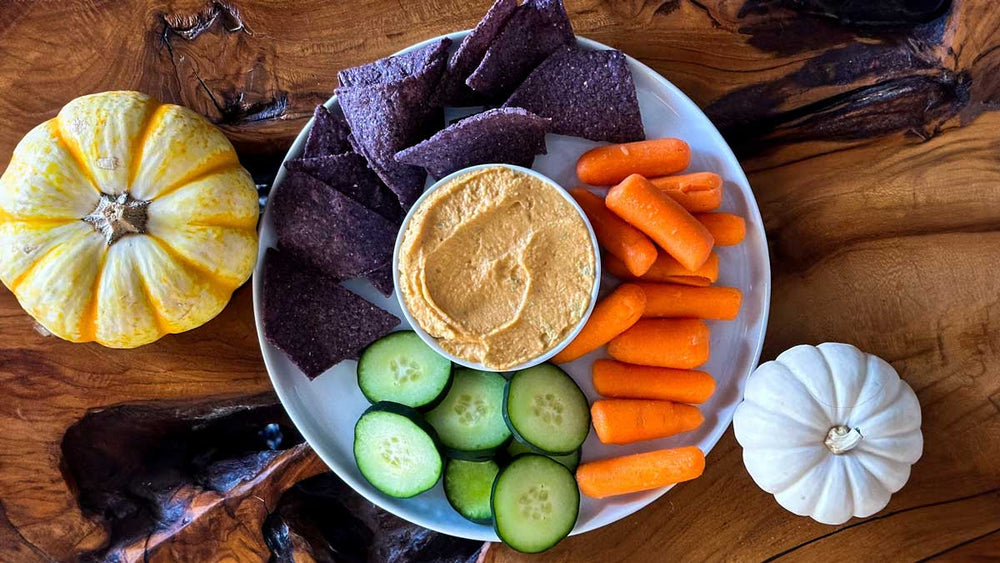Introduction
Hummus, a creamy and versatile dip made primarily from chickpeas and tahini, has become a kitchen staple. As fall is approaching, pumpkin-flavored foods, from lattes to baked goods, are taking center stage. Combining the rich flavor of pumpkin with the smooth, savory texture of hummus creates a unique and delicious twist on this classic dish, perfect for fall gatherings or a cozy snack at home.
What is a Chickpea?
A chickpea, or garbanzo bean, is a round, beige legume rich in protein, fiber, B vitamins, and some minerals. It is highly valued for its nutritional benefits, particularly as an affordable, plant-based protein source. Chickpeas have been cultivated for thousands of years, originating in the Middle East, and they are widely used in Mediterranean, Indian, and Middle Eastern cuisines. They offer flavor and a nutritional boost in countless culinary traditions, from hummus to stews and salads.
Origins of Hummus
As mentioned, hummus originated in the Middle East and is a century-old that holds cultural significance in the region. Traditionally made from blended chickpeas, tahini (sesame paste), olive oil, lemon juice, and garlic, hummus has been enjoyed across countries like Lebanon, Israel, and Palestine as a staple of their diet. Often served as part of mezze—a collection of small, shareable dishes—hummus embodies the communal spirit of Middle Eastern dining. The simple yet flavorful ingredients have been used for generations, making hummus a nutritious and symbolic element of Middle Eastern culinary heritage.
How to Make Hummus GERD-Friendly
Consider a few adjustments to make hummus more GERD-friendly, reducing its acidity and potential for stomach irritation. First, cut back on or eliminate lemon juice, which is highly acidic, and replace it with a milder acid like apple cider vinegar or a small amount of water for balance. Garlic, another common trigger, can be substituted with roasted garlic, which is milder, or simply omit garlic completely. Choose tahini sparingly, as it's high in fat, and opt for a smaller quantity or use light tahini. Adding extra olive oil can make the texture smoother without aggravating acid reflux. Finally, consider adding alkaline vegetables like spinach or zucchini to the hummus to reduce its overall acidity.
Why Pumpkin is a Great Alternative
Pumpkin is not only delicious, but it is also nutrient-rich! With its bright orange color, pumpkin is high in the antioxidant beta-carotene, which is converted to vitamin A in the body, supporting vision and fighting infections. Pumpkin is also a good source of fiber and potassium, aiding in muscle contraction and maintaining normal blood pressure. When added to hummus, pumpkin lends a natural sweetness and a smooth, creamy texture that perfectly pairs with traditional ingredients' savory flavors. Its mild flavor and adaptability make pumpkin a versatile addition to various dishes, from soups and stews to baked goods and dips!
Conclusion
Pumpkin hummus is a delicious, nutrient-packed twist on the classic dip. It combines the creamy richness of hummus with the sweet, earthy flavor of pumpkin. It's a perfect way to enjoy the health benefits of both ingredients while embracing the flavors of fall. Whether served as an appetizer, a snack, or a side dish, pumpkin hummus is versatile and easy to customize with your favorite spices or toppings. Give the recipe a try, and don’t be afraid to experiment with your own creative variations!
[[ recipeID=recipe-2m1hytpc5, title=GERD-Friendly Pumpkin Sage Hummus ]]





















Comments
Join The Conversation...